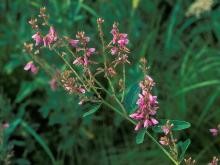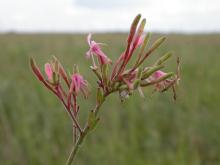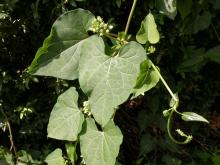Wildflowers, Grasses and Other Nonwoody Plants
Media

Species Types
Scientific Name
Desmodium spp. (17 species in Missouri)
Description
Missouri has 17 species of tick trefoils, which live in a variety of habitats. Hikers know them well from their chains of hairy little seedpods that stick to clothing like parasites!
Media

Species Types
Scientific Name
Oenothera filiformis (formerly Gaura longiflora, G. biennis)
Description
Large-flowered gaura is a tall plant whose white flowers turn pinkish as they age. Four petals point upward, then bend back, and 8 stamens droop downward. The flowers look something like small butterflies.
Media

Species Types
Scientific Name
Symphyotrichum novae-angliae (formerly Aster novae-angliae)
Description
One of our showiest native fall-blooming wildflowers, New England aster contributes to Missouri's colorful autumn landscape. The petallike ray florets of wild plants range from reddish purple to purple.
Media
Species Types
Scientific Name
Erigeron philadelphicus
Description
The antique belief that this plant might repel fleas gives the fleabanes their name. There are more than 170 fleabanes in the genus Erigeron in North America. This one is scattered to common nearly throughout Missouri. Native Americans used this species medicinally for a variety of ailments.
Media

Species Types
Scientific Name
Echinacea purpurea
Description
The large, showy, rose-purple flower heads of purple coneflower make it a standout in open woodlands as well as in the home garden. The genus name, Echinacea, means “hedgehog” and refers to the flower’s spiny center cone.
Media

Species Types
Scientific Name
Geum canadense
Description
White avens, a common wildflower in the rose family, may not catch your eye during hikes, but you will probably notice the seeds clinging to your socks when you get home!
Media

Species Types
Scientific Name
Lobelia cardinalis
Description
Cardinal flower provides a splash of bright red along streams and rivers, in bottomland forests, in ditches by roads, and in other wet places. It's a long-blooming Missouri native wildflower.
Media

Species Types
Scientific Name
Helianthus grosseserratus
Description
A giant of a wildflower, sawtooth sunflower reaches 16 feet in height and sometimes occurs in dense colonies of clumping stems. It has long, coarsely toothed, lance-shaped leaves with winged petioles.
Media

Species Types
Scientific Name
Cynanchum laeve
Description
Bees, butterflies, and other insects love its nectar, but sand vine is also a problem weed that can be difficult to eradicate. Some people cultivate it as an ornamental. Beekeepers value it as an excellent honey plant.
Media

Species Types
Scientific Name
Asclepias syriaca
Description
Common milkweed is famous as a food plant for monarch butterflies. It bears curious seedpods bearing seeds that fly on silky parachutes. It's common statewide in a variety of habitats.
See Also
About Wildflowers, Grasses and Other Nonwoody Plants in Missouri
A very simple way of thinking about the green world is to divide the vascular plants into two groups: woody and nonwoody (or herbaceous). But this is an artificial division; many plant families include some species that are woody and some that are not. The diversity of nonwoody vascular plants is staggering! Think of all the ferns, grasses, sedges, lilies, peas, sunflowers, nightshades, milkweeds, mustards, mints, and mallows — weeds and wildflowers — and many more!





















